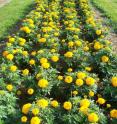Alternatives to pine bark and peatmoss identified for commercial, home gardens
Pine bark and peatmoss are the two most common substrates used for horticultural crop production in the southeastern United States, but both media can present challenges to growers. Reduced forestry production and increased use of pine bark as fuel and landscape mulch has made the medium less available, while the price of peatmoss is rising due to transportation costs and growing environmental concerns over the mining of peat bogs in Canada and Europe. These and other factors have contributed to a demand for new alternative substrates for container production of horticultural crops. The use of agricultural waste and other composted materials is not a new concept, but factors such as consistency and reproducibility of product, disease and insect infestation, and availability of composted materials often influence growers' decisions regarding the use of these materials.
Alternative substrates grown from wood and wood-based products have been investigated as suitable substrates or substrate components in nursery and greenhouse crop production. European research has resulted in numerous successful commercialized wood substrates. More recently, a pine tree substrate called WoodGro™ has been developed from ground whole loblolly pine logs to successfully produce a wide range of nursery and greenhouse crops.
To identify other effective alternative substrates, researchers from Virginia Polytechnic Institute and State University published a research report in the latest issue of HortTechnology that evaluated the landscape performance of annual bedding plants grown in a ground pine tree substrate (PTS) produced from loblolly pine trees or in ground pine bark (PB).
Robert D. Wright, Brian Jackson, Michael Barnes, and Jake Browder studied annual plants begonia, coleus, impatiens, marigold, petunia, salvia, and vinca during a 3-year study from 2005 to 2007. The annuals were transplanted into the landscape and grown at three different fertilizer rates. According to Wright, "Visual observations indicated that all species, whether grown in PTS or PB, had comparable foliage growth, foliage color, and flower density in the landscape trial beds. Also, visual observations of excavated PB and PTS root systems for 2005 indicated comparable root proliferation into the surrounding soil whether grown in PB or PTS. In 2006 the quality of plants (size and foliage quality) was similar regardless of substrate in which plants were grown."
With few exceptions, dry weight and plant size for all species increased with increasing fertilizer additions, regardless of the substrate in which the plants were grown. The study results demonstrated that landscape annuals, whether grown in PB or PTS, are equally acceptable under normal landscape fertilization regimes. Wright concluded that this research indicates that "the utilization of PTS as a substrate for the production of landscape annuals may be acceptable in the context of landscape performance."
Source: American Society for Horticultural Science
Other sources
- Alternatives to pine bark and peatmoss identified for commercial, home gardensfrom PhysorgThu, 26 Mar 2009, 16:37:44 UTC
